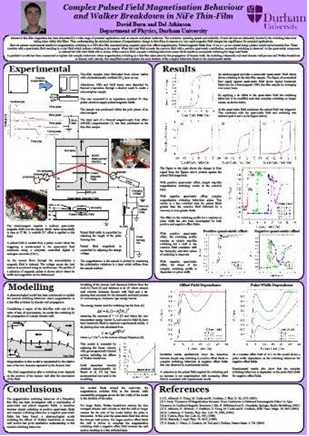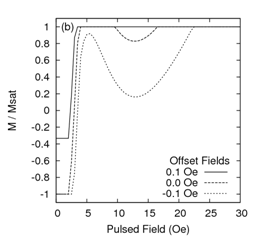
Complex pulsed field magnetisation behaviour and Walker breakdown in NiFe thin-film
D.M. Burn and D. Atkinson
Condensed Matter and Materials Physics Warwick Dec 2009
Interest in thin-film magnetism has recently been stimulated by a wide range of potential applications ranging from sensors to devices such as hard disk read heads. The maximum operating speeds and reliability of such devices are ultimately limited by the switching behaviour taking place within thin-films inside the device. Thus, understanding the physical processes of magnetisation change in thin-films in response to very rapid magnetic field changes has significance for potential applications.
Here we present experimental results for magnetisation switching in a NiFe thin-film measured using magneto-optic Kerr effect magnetometry. Pulsed magnetic fields from 10 ns to 1 us are created using a pulser circuit and microstrip line. These combine with a quasi-static field resulting in a total field which induces switching in the sample. When this total field exceeds the coercive field with a positive quasi-static contribution, successful switching is observed. As the quasi-static component is reduced but with total fields still in excess of the coercive field, complex switching behaviour arises which results in incomplete switching for large total fields. Figure 1a shows the experimental results where a change in behaviour occurs between positive and negative offset fields.
A qualitative model has been constructed to explain this complex behaviour where magnetisation switching in a thin-film takes place by the propagation of domain walls. By including a thermally activated domain wall process and Walker breakdown in domain wall velocity, this simplified model explains the main features of the complex behaviour found in the experimental results (see figure 1b).


Figure 1: The change in magnetisation switching from simple step-like behaviour at positive offset fields to complex behaviour at negative offset fields. This has been observed in experimental results (a) where the key features are explained by a simple domain wall propagation model (b).